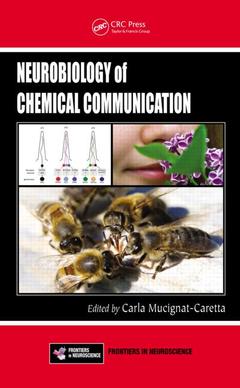Description
Neurobiology of Chemical Communication
Frontiers in Neuroscience Series
Coordinator: Mucignat-Caretta Carla
Language: English
Subjects for Neurobiology of Chemical Communication:
Keywords
AOB; Antennal Lobes; chemical signals; Pheromone Components; Pheromones; ORNs; olfaction; Main Olfactory System; intraspecific communication; Sexual Pheromones; Trichoid Sensilla; Pheromone Blend; OBP; AOS; Sensillum Lymph; Odor Receptor; Olfactory Sensilla; Human Pheromones; Pregnancy Block; Basiconic Sensilla; Olfactory Bulb; VNO; MOE; Cuticular Hydrocarbons; Young Men; Pheromone Signals; Big Cats; Olfactory System; Vomeronasal Receptors
480 p. · 15.6x23.4 cm · Paperback
Description
/li>Contents
/li>Readership
/li>Biography
/li>
Intraspecific communication involves the activation of chemoreceptors and subsequent activation of different central areas that coordinate the responses of the entire organism?ranging from behavioral modification to modulation of hormones release. Animals emit intraspecific chemical signals, often referred to as pheromones, to advertise their presence to members of the same species and to regulate interactions aimed at establishing and regulating social and reproductive bonds.
In the last two decades, scientists have developed a greater understanding of the neural processing of these chemical signals. Neurobiology of Chemical Communication explores the role of the chemical senses in mediating intraspecific communication. Providing an up-to-date outline of the most recent advances in the field, it presents data from laboratory and wild species, ranging from invertebrates to vertebrates, from insects to humans.
The book examines the structure, anatomy, electrophysiology, and molecular biology of pheromones. It discusses how chemical signals work on different mammalian and non-mammalian species and includes chapters on insects, Drosophila,honey bees, amphibians, mice, tigers, and cattle. It also explores the controversial topic of human pheromones.
An essential reference for students and researchers in the field of pheromones, this is also an ideal resource for those working on behavioral phenotyping of animal models and persons interested in the biology/ecology of wild and domestic species.
Introduction to Chemical Signaling in Vertebrates and Invertebrates. Pheromones and General Odor Perception in Insects. First Investigation of the Semiochemistry of South African Dung Beetle Species. Pheromone Reception in Insects: The Example of Silk Moths. Chemical Communication in the Honey Bee Society. Drosophila Pheromones: From Reception to Perception. How Drosophila Detect Volatile Pheromones: Signaling, Circuits, and Behavior. Chemical Signaling in Amphibians. Vomeronasal Organ: A Short History of Discovery and an Account of Development and Morphology in the Mouse. Vomeronasal Receptors and Signal Transduction in the Vomeronasal Organ of Mammals. Central Processing of Intraspecific Chemical Signals in Mice. Molecular and Neural Mechanisms of Pheromone Reception in the Rat Vomeronasal System and Changes in the Pheromonal Reception by the Maturation and Sexual Experiences. Social Cues, Adult Neurogenesis, and Reproductive Behavior. Influence of Cat Odor on Reproductive Behavior and Physiology in the House Mouse (Mus Musculus). Pheromone of Tiger and Other Big Cats. Cattle Pheromones. Pheromones for Newborns. Pheromone Processing in Relation to Sex and Sexual Orientation. Human Pheromones: Do They Exist? Index.
Carla Mucignat-Caretta, PhD, is associate professor of physiology at the Department of Molecular Medicine, Medical School, University of Padova in Italy. She earned a PhD in neuroscience at the University of Parma, Italy, working on the role of major urinary proteins as pheromones in mice. She next moved to the University of Padova as a researcher and eventually associate professor. Her research focus is on the intraspecific chemical communication in mice, from chemical identification of the stimuli to the behavioral and neurohormonal effects induced in the recipient mice, and to the modifications in the brain circuits implied in deciphering chemical signals throughout the lifespan.
These books may interest you

Chemical Signals in Vertebrates 105.49 €



